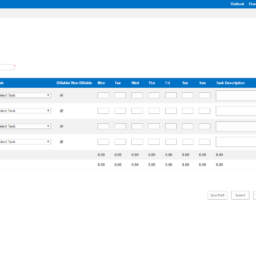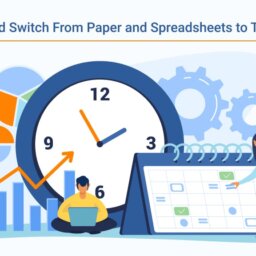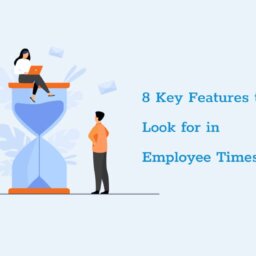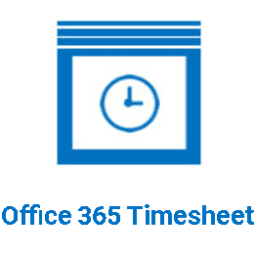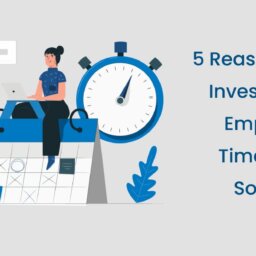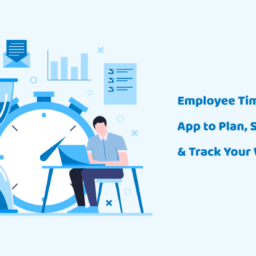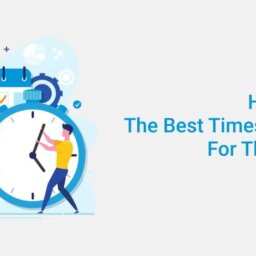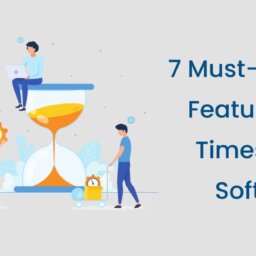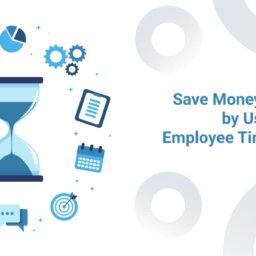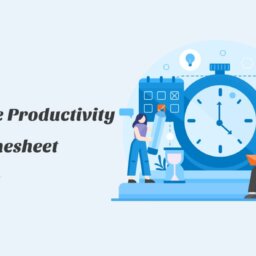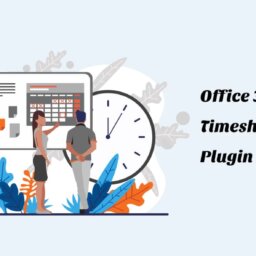Time Tracking - An Overview
Employees are critical assets for organizations irrespective of the company size, scale, industry vertical, and expertise. Employees represent the organization they work for in front of the clients, customers, and other key external stakeholders. They are the ones who walk the extra mile to make the organizations’ vision and mission achievable. In a nutshell, employees’ productivity is crucial for organizations today and tomorrow.
There are many ways, both time-tested and the latest trendy ones that have been leveraged to gauge employee productivity. And, time tracking is one of the key methodologies that has been there, is there, and will always be there for the unforeseen future, and rightfully so! Employee time tracking helps in determining employee productivity, efficiency, and ultimately whether an investment is yielding meaningful returns or not. Companies invest heavily in manual and digital time tracking software to track employee productivity, a critical component of performance management.
Benefits of Time Tracking
Measuring employee productivity through time tracking can help with a variety of business metrics. Time tracking is the act of logging and monitoring employee’s work hours and accomplishments. This data gives business owners and managers meaningful insights. Time tracking has been around for a long while in various shapes and forms, but only in the last decade, it has received a lot of interest from both companies and individuals. Here are some of the key benefits of time tracking.
Improved Productivity
Employees tend to spend their designated work hours on multiple projects and a plethora of tasks, and sub-tasks. And, given the new normal circumstances, and the wide-scale adoption of the remote working culture, measuring, and ensuring employee productivity is critical for business success. While multitasking is the need of the hour, studies cite that multitasking may reduce employees’ productivity by approximately 45%. Here comes the role of time tracking enabled by robust time tracking software. This employee timesheet application helps employees record the hours spent on each project, task, and sub-task, which offers profound insights into their performance. This also enables employees to have better time management skills. Timesheet applications also alert the employer of the idle time spent by their employees, and if any particular task is taking longer than expected. Such scenarios will help both employees and employers look into the task, and undertake necessary actions.
Enhanced Accountability
Employee productivity and accountability are interlinked. For instance, an employee who is yet to receive due recognition for their project-level performance may hesitate to stay accountable. Without proper time tracking capability and inadequate 360-degree project visibility, there could be ambiguous claims regarding project contributions. A timesheet application offers greater visibility to employers on which employee is working on what, what all tasks they have accomplished, and the time being invested on each task/project. This will enhance employee accountability in more than one way. It will empower employee-employer transparency and trust. The timesheet application also helps employers pick productive employees, their performance trends and appraise them accordingly.
Task Transparency
The timesheet application is not only for time tracking; it is also for project-level task visibility. Project managers can create unlimited projects on the Microsoft Office 365 timesheet within their SharePoint instances. Then they can create relevant tasks and sub-tasks and assign them to designated employees. As a result, project managers can accurately have information about who is working on which tasks and whether the tasks are on track or not. Any discrepancies can alert the project managers to reassess their employees’ workload and if needed, reassign the pending tasks to someone else. They will also analyze if an employee is procrastinating or being idle at work due to unwarranted reasons. Such levels of task and project transparency can prove highly beneficial for both employees and organizations.
Billing, and Operational Efficiency
Timesheets are essential for organizations to raise accurate, on-time, and efficient billing/invoices for clients. Timesheets can also be leveraged for internal HR and payroll processing purposes. The timesheet application offers data-driven reports on billable, and non-billable tasks, which will provide clients with more significant and data-backed insights. Project managers can plan billable hours by preparing the project deliverables accordingly to improve business ROI.
Optimal Resource Utilization
When it’s about resources, it can mean both the time spent and the costs associated with a project. Timesheet applications alert the project managers whether a particular project needs additional help in terms of time and monetary aspects. This will pave the way for optimal resource utilization.
Types of Time Tracking
Time tracking holds high significance for organizations. Without time tracking, the management of tasks and the creation of invoices would be horrendous. It is essentially categorized into personal time tracking, and project time tracking. Personal time tracking helps individuals to track their activities in detail and project time tracking helps people to track the amount of work done on a particular task to get paid for it.
Personal Time Tracking
Personal time tracking is mostly geared towards ensuring employee productivity, and engagement. Within the designated SharePoint instances, employees can record their clock-in and clock-out times and their task deliverables across multiple projects in an easy, efficient, and seamless manner. Knowing what they have on their table for today and tomorrow will help them plan their work better ahead of time. Such a level of productivity is highly beneficial for both employees and organizations. It’s not like employees have to submit their timesheets daily; they can create drafts, keep editing them, and then submit them weekly or monthly. It is time-efficient for both them and their team leader, who is going to save a lot of time going through timesheets daily. Employees can show their tasks as billable or non-billable with timesheets, justify their contributions to individual projects, and the overall organizational front. This personal time tracking data will help organizations in their HR and payroll departments to streamline functions.
Project Time Tracking
No matter how efficient the workforce is, juggling multiple projects simultaneously may be overwhelming. There are bound to be a few slip-ups that may cost the organization dearly. A robust time tracking system offers holistic project time tracking capabilities, which organizations can massively benefit from. PMs can know from the beginning the precise timelines by when a project and the designated tasks/subtasks will be completed and communicate the same to the clients so that there are no mismatched expectations. Timesheets will also help PMs allocate time and resources as needed across projects judiciously. PMs also can ensure that the projects stay on track and are being accomplished on time.
Introducing Time Tracking to Employees
Time tracking, no matter how essential it is, often tends to put employees in the spotlight. No employee would prefer all his work hours to be micromanaged by their superiors and dissected at length. And, mostly, employees might have a negative perception of time tracking systems. Thus, organizations must ease their employees through the learning curve and positively introduce time monitoring. Employees should not feel it is an invasion of their privacy, professional ethics, or way of working. Instead, they should start perceiving it as a tool to strengthen their portfolio further and manage their workload seamlessly.
Time-efficient
There are days when employees will have too much on their tables and some days may be relaxing in terms of workload. Still, managing the 8-hour workday is essential. Not having a clear view of the workday won’t help the employees plan their work efficiently. And, the timesheet application is here to address this concern. Employees can look at their daily workload, work patterns and see how they can improve their productivity. This will also help enhance their personal branding and growth aspects.
Data-driven Employee Performance Measurement
When it goes unnoticed, hard and smart work may discourage employees from giving their best in the future. Besides, there is the scenario where someone else is getting the credit for work. Timesheets will eliminate all these challenges. A PM is aware of which employee is working on which project and which tasks. This offers the PMs data-driven reports about a particular employee’s performance. And key contributors can get recognized accordingly. There will hardly be any resistance and premonitions when the benefits of a time tracking system is effectively communicated to the employees.
Future Task Timeline Forecasts
Timesheet applications enable organizations with clear project and task level views. They know what type of tasks are taking longer and why. This will help PMs forecast the task or project timelines in the future precisely to avoid project completion delays and other bottlenecks in project management. More often, managers might not have the idea about the time needed to complete a task. While they are entrusted to set the workflow in motion, timesheets will be indispensable in their journey.
Even Work Distribution
In an organization, there are a bunch of employees who have a jolly good time while some keep bearing the burden of an endless stream of tasks. This is not productive for organizations both in the short, and long run. Even work distribution is the key here to boost employee morale and productivity. Timesheets will clearly show the PMs which employee is being overworked, and where there might be extra resources needed. This will help them plan the workloads better ahead of time. They can also ensure the key contributors don’t go unnoticed.
The Do’s and Don’ts of Employee Time Tracking
DO Inform Your Employees – Time tracking and management are paramount for organizations and so do for employees. Before implementing any time tracking solution/platform, organizations must communicate the same to their employees. This will help them clear off the air, boost productivity, trust, and transparency. Employees will also not feel like they are being kept under constant vigil, which may become counterproductive too. Organizations must take their employees through the “Awareness” journey and prepare them for the time tracking system that’s there to stay for good.
DON’T Breathe Down Employees’ Neck – No employee will appreciate their superior breathing down their neck, and micromanaging the tasks assigned. And, when the employee has to report each of his/her task statuses constantly, it may feel the same, of course in a virtual manner. Organizations must educate the employees that the time tracking system is not here for interfering with their personal time or break hours, etc. Employees should perceive time tracking as a tool for their greater benefits rather than another organizational obligation.
DO Use Time Tracking to Boost Employee Motivation
Motivation plays a key role in employee productivity, efficiency, and loyalty towards the organization. For instance, an employee who is not motivated enough for his/her contributions at work, might not feel the need to take the last mile for perfection. Organizations can leverage the time tracking details to identify which employees are being the key contributors and reward or recognize them accordingly. This will be a booster for the high-performing employees, and otherwise too. Other employees will also view the road and prize ahead for their contributions.
DON’t Step the Boundary
Time tracking systems enable organizations to have a 360-degree view of projects and tasks. There could be tasks that might need extra time and resources, and delays might be genuine. Before jumping to conclusions, organizations must try to identify the cause behind the delay and take corrective measures accordingly.
DO View the Holistic Picture
An endless list of projects in the pipeline is exciting for organizations. And, with it, comes the responsibility of juggling multiple projects, and a humongous amount of tasks, and sub-tasks. The timesheet application helps project managers view the holistic picture of their organizational performance in a unified dashboard. This helps PMs identify task patterns, and loopholes, which they can keep in consideration to streamline their project management processes.
What to Look for While Selecting the Time Tracking Software
Time tracking is even more critical in today’s context of new normal, and the indispensable remote working culture.
Here are the key aspects to consider while opting for a time tracking system.
- Considering the wide-scale demand, the market is replete with a plethora of time tracking solutions with different features, and add-ons. However, an on-time tracking system that works best for an organization might not be ideal for another. It all depends on the organization, its workforce strength, and other factors. Organizations can choose from punch in/out systems, background capturing systems, and manual tracking systems. Punch in/out systems are more of employee attendance trackers than time monitoring systems and are ideal for organizations with client servicing teams or teams working in shifts. This will help organizations prevent tardiness at work, and keep things in perspective. While weighing options for time tracking systems, organizations must find the objective of the entire endeavor and then proceed accordingly.
- Time tracking systems are available as on-premise and SaaS platforms. For on-premise time tracking systems, the employee time-related data is stored on the organization’s internal servers that can be accessed with due authorization. However, SaaS-based time tracking systems can be accessed anytime, anywhere as the data is available on a central, cloud repository. Organizations can also go for timesheet apps that employees can easily implement on the go. Browser additions, often lightweight, can also be leveraged to assist an organization’s employee time tracking endeavor.
- Data storage, operating system, time tracking method, data import/export, integrations are other key features to watch out for while choosing a time tracking system.
- Pricing is also a key attribute to be taken into consideration while choosing time tracking systems. A hefty price does not always equate to premium features and capabilities. Organizations must be prudent at this decision, look for monitoring systems with requisite features, and not go overboard unnecessarily.
- Organizations must get time tracking systems that leverage automation technologies. Indeed, you want your workflows to be streamlined, and not overlapping, and ambiguous. And, getting things done, such as manually making time entries, is no longer enough and not scalable for the future.
Why Ignatiuz
Ignatiuz has been instrumental in creating intuitive, technology-driven, and cutting-edge solutions for tools and platforms for enabling organizations in their success and growth journey. The Microsoft Office 365 Timesheet is one of the most-coveted tech solutions brought to the fore by Ignatiuz.
Some of the key features include:
- Microsoft Office 365 timesheet software empowers organizations in creating unlimited projects and tasks within their secure SharePoint environment. The time tracking capability is scalable for both the organization and its workforce. Only designated authorities and employees can have the authorization to create new tasks or subtasks under an existing project.
- The Office 365 Timesheet app helps employees record their daily hours spent, which can be submitted weekly, bi-monthly, or monthly. Project managers can validate the employee timesheets periodically to ensure on-time project delivery.
- The Microsoft Office 365 timesheet software is available for both Android and iOS platforms. So, organizations won’t have to worry about accommodating extra infrastructure investments.
- Tracking individual employee contributions daily can get redundant and time-intensive for the project managers. The SharePoint Timesheet app helps them review and approve employee timesheets available in digital formats on the go.
- This SharePoint-based time tracking application helps organizations in segregating employee efforts into billable and non-billable categories. This is especially helpful in employee payroll management, performance appraisal as well as client invoicing purposes.
- The employee timesheet app enables organizations with precise, robust reporting specific to each task and project. With this greater visibility, project managers can approve/reject the timesheets based on the employee’s inputs, which will instantly notify the employees. This helps the concerned employee make the necessary corrections or readjust their priorities.
Key reasons for opting for the Microsoft Office 365 timesheet solution by Ignatiuz are:
- Time tracking details are stored in cloud-based, centralized, secure SharePoint instances, eliminating the need for manual data transfer/access challenges and data theft issues. The project and task-level data can be accessed anytime, anywhere.
- The timesheets can be exported into Excel?CSV/PSD formats for better ease of usage.
- Armed with Power BI integration, this time tracking application helps organizations and project managers derive data-driven, actionable, insightful employee performance reports.
- A robust, resilient, and scalable solution.
- Available in Standard, Professional, and Enterprise variants with dynamic features.
Wait no more, get started with Ignatiuz!
